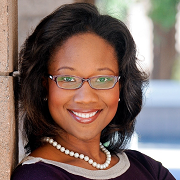- About MAA
- Membership
- MAA Publications
- Periodicals
- Blogs
- MAA Book Series
- MAA Press (an imprint of the AMS)
- MAA Notes
- MAA Reviews
- Mathematical Communication
- Information for Libraries
- Author Resources
- Advertise with MAA
- Meetings
- Competitions
- Programs
- Communities
- MAA Sections
- SIGMAA
- MAA Connect
- Students
- MAA Awards
- Awards Booklets
- Writing Awards
- Teaching Awards
- Service Awards
- Research Awards
- Lecture Awards
- Putnam Competition Individual and Team Winners
- D. E. Shaw Group AMC 8 Awards & Certificates
- Maryam Mirzakhani AMC 10 A Awards & Certificates
- Two Sigma AMC 10 B Awards & Certificates
- Jane Street AMC 12 A Awards & Certificates
- Akamai AMC 12 B Awards & Certificates
- High School Teachers
- News
You are here
A Mathematical Mindset: Mitigating America's Achievement Gap

“Question for you,” Talithia Williams (Harvey Mudd College) told herd audience in the MAA Carriage House on June 8. “As of 2008, what percent of white Americans between the ages of 25 and 34 had at least an associate’s degree?”
“Twenty-four percent,” ventured one listener.
“Sixty,” countered another, laughing at his own optimism.
After entertaining a smattering of other guesses, Williams disclosed the statistic: “Thirty-eight percent,” she said. “What percentage of black Americans?”
Here estimates clustered around 10 percent, though the actual figure is 26 percent.
“That is a wonderful example of lowered expectations,” remarked Ezra “Bud” Brown (Virginia Tech).
And so transpired perhaps the most interactive installment of MAA’s NSA-funded Distinguished Lecture Series. In “A Mathematical Mindset: Mitigating America’s Achievement Gap” Williams not only presented information about and ideas for combatting education inequity in the United States, but also encouraged audience members to offer their own perspectives.
The Gap(s)
Williams defined an achievement gap as “any persistent disparity in academic performance between different groups of students, or the unequal distribution of educational results,” and prompted attendees to name some commonly discussed gaps.
Gaps exist between American students and those from other countries, between students from low- and high-income households, between native speakers of English and those for whom it is a foreign language. There are performance disparities between male and female students, between Asian/Caucasian students and those in other groups.
“What do you think the number one cause of the achievement gap is?” Williams asked.
“Poverty,” piped up several listeners in unison.
Other contributing factors include inferior educational resources, familial instability, flawed assessments, and those lowered expectations Bud Brown mentioned.
Stereotypes of minorities often lead schools to expect less of African-American and Hispanic students, to enroll them in less challenging courses.
“‘Oh sweet darling, it’s just a blessing that you’re not in a gang,’” Williams said, echoing the message sent to countless minority students across the country. “‘You don’t need a degree. You don’t need to be college-ready. You just do what you can. I’m just so proud of you for showing up at school today.’”
Growth Mindset
A first step in resolving the achievement gap, Williams said, is promoting a growth mindset.
Drawing on the work of Carol Dweck, Williams contrasted a growth mindset with a fixed mindset, in which intelligence and talent are viewed as inborn, immutable traits.
“In a growth mindset people believe that these abilities can be developed through dedication and hard work,” Williams explained.
The idea that intelligence can be developed motivates students to embrace challenges, Williams said, to persist despite obstacles, to learn from criticism, and to see effort as the path to mastery.
To encourage a growth mindset, you don’t let a student off with, “Great effort! You tried your best.” That comment accepts less than optimal performance. A better tack is to tell a struggling student that the point isn’t to get it all right away. “The point is to grow your understanding step by step,” you might say. “What can you try next?”
Math Mindset
Williams cited work by the U.S. Department of Education’s Clifford Adelman showing that the more mathematics a student studies in high school, the greater his or her chance of earning a bachelor’s degree (in any subject).
Why the correlation? Williams attributed it to the assumption that, if you do math, you must be smart and the effect this has on students who shine in mathematics but don’t immediately excel across the board.
“When I would go to those other classes where I wasn’t as good, you know what I would think?” Williams asked. “‘I’m in trigonometry. I must be smart! How hard can this essay be?’ I pushed myself in these other courses because I was told I was so smart in math.”
Success in math forces a growth mindset, Williams said.
What You Can Do
Williams closed her talk by describing the Sacred SISTAHS Math and Science Conference that brings African American girls ages 12 to 18 to the Harvey Mudd campus each year to meet African American women working in STEM fields.
“This event can be transformative because it gives you an image of what you can become,” Williams said, remembering how the late Claudia Alexander of NASA’s Jet Propulsion Laboratory did that for her as a teen. “Often I would hold onto her image when I would struggle in grad school. I was like, ‘Well, Claudia did it.’ I didn’t have to call her. I didn’t have to email her. I just knew that I could do it because of her.”
And even if you don’t have the wherewithal to organize an annual conference, Williams assured her Carriage House audience, you too can help chip away at the achievement gap.
“Often we think, ‘Oh my gosh, I can’t affect the achievement gap. It’s so big,’” Williams said. “But you know somebody who is probably in poverty or first-generation. You can affect that one person, and in doing that you will affect the generations that come behind them.”
Katharine Merow is a freelance writer living in Washington, D.C.




